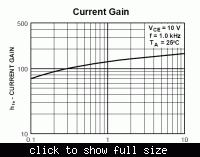tahir4awan
Full Member level 4

- Joined
- Nov 29, 2010
- Messages
- 213
- Helped
- 16
- Reputation
- 32
- Reaction score
- 17
- Trophy points
- 1,308
- Location
- Germany
- Activity points
- 3,116
Hello Friends I have a question regarding transistor operation hope you guys help me.
As we know in common emitter configuration when base current increases , collector current also increases while Vce collector to emitter voltage decreases.
I was reading 2N3904 data sheet I was confused when I saw Hfe (DC gain) table.
There was given different Hfe for different Ic but it was strange that Vce is constant for all ranges of Ic and Hfe.
How it is possible that variation Ic is not affecting Vce.
Well this is my second post so I cannot insert links so please read data sheet of 2N3904 transistor .
As we know in common emitter configuration when base current increases , collector current also increases while Vce collector to emitter voltage decreases.
I was reading 2N3904 data sheet I was confused when I saw Hfe (DC gain) table.
There was given different Hfe for different Ic but it was strange that Vce is constant for all ranges of Ic and Hfe.
How it is possible that variation Ic is not affecting Vce.
Well this is my second post so I cannot insert links so please read data sheet of 2N3904 transistor .





